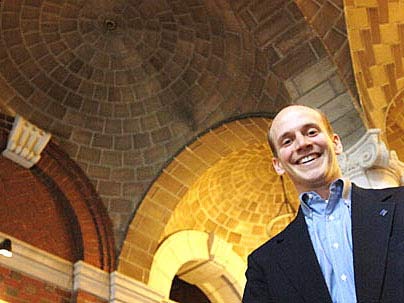Yoda Helps Unlock Cathedral Mysteries

What do Yoda and Gothic cathedrals have in common? More than being several hundred years old, as it turns out.
Computer animation software used in newer "Star Wars" films to bring the pint-sized Jedi to life has now been modified to investigate the mysteries of cathedral architecture.
Along with having many practical uses for architects today, the technology could unlock some of the trade secrets guarded by stonemason guilds for centuries.
Pressure points
Engineers and architects working together at the Massachusetts Institute of Technology developed the software, known as particle-spring systems. It works by turning the lines and points of pressure within the building blocks of any structure into a three-dimensional graphic. Architects can input information to the software and create a virtual "mesh" of their project within minutes, showing how each block will react in relation to the other.
In the same way, the software can instantly explain just how builders in the 12th and 13th centuries were able to accomplish the seamless stonework displayed in Europe's greatest cathedrals.
The key lay in finding those pressure points, said project leader John Ochsendorf, an assistant professor of architecture at MIT.
Sign up for the Live Science daily newsletter now
Get the world’s most fascinating discoveries delivered straight to your inbox.
"To understand the function of cathedrals, we are looking for lines of internal compression force which transfer the weight of the stones down to the ground," Ochsendorf told LiveScience. "If we cannot find internal lines of force within the thickness of the vaults and the walls of the cathedral, then it is not capable of standing."
MIT's particle-spring software makes identifying the lines of force easier, according to Ochsendorf. This may be particularly useful in the case of old buildings showing signs of wear, where cracks can be identified as either harmless or potentially fatal to the structural integrity of the building.
God, man, and architecture
The technology, if it works as planned, could also add valuable information to the historical record. Cathedrals were used as status symbols for the stoneworkers and those who commissioned the building, in addition to being places of worship, social scientists say.
"Although it is made of stone and glass, to understand and see it for what it is, we need to understand the relations among God, man, and architecture that governed its creation," writes Stanford University sociologist Robert Scott, in his book "The Gothic Enterprise: A Guide to Understanding the Medieval Cathedral" (University of California Press, 2003).
How cathedrals were constructed, then, can say a lot about the circumstances of why and by whom they were built. Ochsendorf and the team at MIT believe the precise details of how will be illuminated with their particle-spring approach.
"The exact order of construction for a complex Gothic cathedral is unknown," Ochsendorf said. "For example, at what point were the flying buttresses added to a cathedral? We could begin to demonstrate that some sequences of construction were impossible of standing safely, which would give new insights into the creation and development of cathedral design."
While his focus currently lies on investigating the past, Ochsendorf hopes to see the particle-spring systems used for practical purposes in the future, too.
"This new tool shows great promise for the invention of new building shapes which can carry loads more effectively and with less material," he said.
- The World's Tallest Buildings
- Murky History of Quirky 'Da Vinci Code' Chapel
- American Architecture: Form Doesn't Follow Function
- Parthenon Once a Riot of Color
- Gallery: Architects and Buildings










